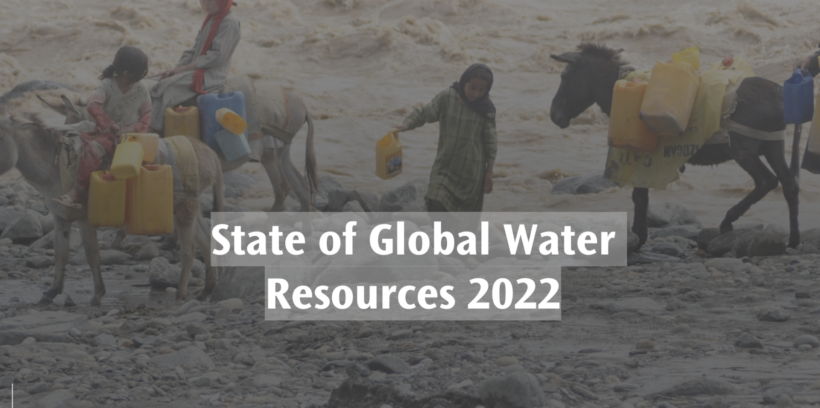According to a new report from the World Meteorological Organization (WMO), the planet’s hydrological cycle is “spinning out of balance” due to human activity and climate change.
Extreme rainfall and droughts, seemingly two opposites on a spectrum of extreme weather, are bringing unprecedented and frequent damage to communities. Flooding from melting ice, snow and glaciers has increased as water security is threatened for millions.
WMO says not enough is known about the real state of the planet’s freshwater resources.
“We cannot manage what we do not measure,” the agency’s State of Global Water Resources 2022 report said in a plea for elemental policy change.
The report says investments must be increased to facilitate cross-border collaboration and water resources assessments, improved monitoring and data sharing, a press release from WMO said.
“This WMO report offers a comprehensive, and consistent overview of water resources worldwide, highlighting the influence of climate, environmental, and societal changes,” said WMO Secretary-General Petteri Taalas, according to UN News.
The new WMO report expands on last year’s pilot, with more information on hydrological variables like soil moisture, evaporation, groundwater, streamflow, frozen water, terrestrial water storage, reservoir inflows and hydrology-related disasters, the WMO press release said. It combines remote satellite-based sensing data with numerical modeling simulations and field observations to assess global water resources.
“Glaciers and ice cover are retreating before our eyes. Rising temperatures have accelerated – and also disrupted – the water cycle. A warmer atmosphere holds more moisture. We are seeing much heavier precipitation episodes and flooding. And at the opposite extreme, more evaporation, dry soils and more intense droughts,” Taalas said in the press release.
In order to provide holistic and integrated information for policy makers, the report brings together expert opinions and is a complement to WMO’s report on the State of the Global Climate.
“The overwhelming majority of disasters are water-related and so water management and monitoring lies at the heart of the global Early Warnings for All initiative. Many of the countries targeted for priority action in Early Warnings for All suffered from major floods or droughts in 2022. Not a single country had timely and accurate hydrological data available to support evidence-based decision making and early action,” Taalas said. “This report is a call to action for more data sharing to enable meaningful early warnings and for more coordinated and integrated water management policies that are an integral part of climate action.”
According to UN Water, 3.6 billion people currently face inadequate water access for at least one month each year. By 2050, this number is predicted to increase to more than five billion.
According to UN News, WMO said food security is greatly impacted by limited water resources since upwards of 70 percent of withdrawals of water are used for food production.
The new report quantitatively assesses large river basin water resources as compared to long-term averages for variables like groundwater, evaporation, river discharge, inflow, soil moisture and reservoirs, the WMO press release said.
Last year, more than half of the catchment areas around the world deviated from standard river discharge conditions. Most were drier than normal, with a small percentage of basins showing conditions that were above or much higher than normal.
In Europe, heat waves and drought meant decreased river flows and soil moisture during the summer, as well as increased evaporation. This caused agricultural challenges and closed power plants due to a lack of cooling water.
The change from last year’s La Niña to this year’s El Niño conditions is likely to greatly impact the hydrological cycle as well.
Alpine snow cover was far below average last year. Snow melt from the Alps is essential for rivers like the Rhine, Rhone, Danube and Po. The European Alps also saw unprecedented glacial melt.
“Unfortunately, we have lost this glacier melting game. Glacier melting and sea level rise may continue for the coming thousands of years because of high concentrations of carbon dioxide. In general, we will have challenges to get water for agriculture, for human beings, industry and also for hydropower production,” Taalas said, according to UN News.
Due to continuous drought in the U.S., extremely low water levels on the Mississippi River affected navigation, causing some shipping delays, WMO said.
The Horn of Africa has been suffering a major humanitarian crisis due to prolonged drought.
Pakistan’s Indus River Basin experienced a megaflood that killed at least 1,700 people and affected 33 million. An early-year heat wave had increased glacial meltwater, leading to higher river levels that then swelled following monsoon rainfall in July and August that was more than two times the average.
The report emphasized the lack of verified and accessible hydrological data. Observational data was especially lacking in the Middle East, Africa and Asia.
“There has been a substantial increase in the number of observed discharge data compared to the previous year, which were received from more than 500 stations. After quality control, this was reduced to 273 stations as compared to the 38 stations utilized in the previous report. However, data sharing was limited to only 14 countries, leaving regions such as Africa, the Middle East, and Asia notably underrepresented in terms of available observational data,” the press release said.
The current State of Global Water Resources report includes input from a variety of hydrological experts, including Global Data Centres, National Meteorological and Hydrological Services, supporting organizations like the German Research Centre for Geosciences and NASA, as well as community members.
Cristen is a writer of fiction and nonfiction. She holds a JD and an Ocean & Coastal Law Certificate from University of Oregon School of Law and an MA in Creative Writing from Birkbeck, University of London. She is the author of the short story collection The Smallest of Entryways, as well as the travel biography, Ernest’s Way: An International Journey Through Hemingway’s Life.






